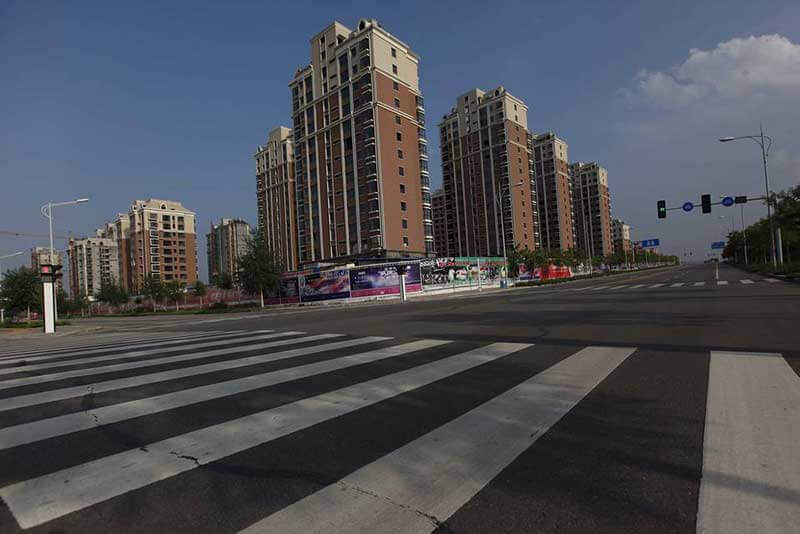- How China’s ghost cities came to be
- Are they really as empty as they seem?
- The population of the so-called ghost cities is starting to increase
You’ve probably heard the story of China’s ghost cities: vast, sprawling, futuristic metropolises built in the middle of nowhere that nobody actually lives in. Imagine the set of The Walking Dead and you might get the idea. Or, at least, that’s what we’ve been led to believe. In reality, those reports have been vastly exaggerated, and the cities described in them are far from empty. Yes, they’re certainly underpopulated, but there’s a very good explanation for it – they’re brand spanking new!
The cities in question are the product of the Chinese government’s great urbanisation plan that originated in the early 1980s and sought to relocate hundreds of millions of the country’s rural inhabitants to cities to fuel economic growth. At the time, China’s population was predominantly rural, with only 180 million people living in cities. Over the next couple of decades, hundreds of new cities have been built all over China, nudging the country on its way to becoming an urbanised nation. There was only one problem – getting people to actually go and live there turned out to be much more difficult than anticipated.
How China’s ghost cities came to be
Historically, there’s always been a natural reason for building a city in a particular location, whether it’s proximity to a water source, fertile land, mineral deposits, or simple geography. Over time, that city would expand almost organically, increasing in size to accommodate its growing population. However, China decided to do things a little bit differently and just build the cities in these locations even if there was no logical reason for them to be there. They were guided by the idea that once the cities were built, people would come on their own.

“Cities and districts built without demand or necessity resulted in what some Chinese scholars have termed, literally, ‘walls without markets’,” says William Hurst, a political science professor at Northwestern University. “Or what we might translate as uncompleted or hollow cities. Political exigency and investment hysteria trumped economic calculus or consideration of genuine human needs.” This created a real catch-22. The people didn’t want to move to areas that lacked basic public services like healthcare, schools, transportation, and shopping centres, while the local governments were reluctant to build the necessary infrastructure until there were enough people already living there to justify the costs. But things are slowly starting to change.
Are they really as empty as they seem?
In 2015, the Chicago-based photographer Kai Caemmerer decided to see for himself what all the fuss was about and pay some of these cities a visit. What he encountered there was not at all what he expected. “I was originally inspired by some of the (almost sensationalist) reports and articles that I had read about the new ‘ghost cities of China,” says Caemmerer. “Digging a little bit deeper, it became fairly clear that many of these ‘ghost cities’ were not at all abandoned or defunct, as they had been depicted, but rather just very new.”
Caemmerer spent about three months exploring three of the so-called ghost cities: the Kangbashi District of Ordos, the Yujiapu Financial District in the Binhai New Area near Tainjin, and the Meixi Lake City near Changsha. Kangbashi, for example, has around 100,000 inhabitants today. Although it was originally designed to hold 500,000 and does feel rather empty at times, you can hardly call a city with 100,000 people living in it a ghost city!
The population of the so-called ghost cities is starting to increase
Established in 1993 and located east of the Huangpu River, Pudong is probably the most successful example of a former ghost city. Once the laughing stock of the entire country when it was filled with empty skyscrapers, the Pudong financial district is now a vibrant financial centre and home to some of the largest and most distinguished financial institutions and companies in the world, boasting 99 per cent occupancy rates. It’s also the most populous district in Shanghai, with more than 5 million inhabitants. Other so-called ghost cities have experienced a similar change of fortune. According to a report published by Standard Chartered, the occupancy rate of Zhengdong New District has doubled from 2012 to 2014, while the population of Zhenjiang’s Dantu quadrupled over the same period. Changzhou’s Wujin district has also seen its occupancy rate increase from 20 to 50 per cent.
While most of these so-called ghost cities have failed to live up to their original promise, very few of them have actually failed completely and are hardly deserving of the nickname that’s been assigned to them. They may have to go back to the drawing board and set some more realistic goals. Most of them should become fully functioning cities eventually. All they need is a little more time.
Share via:


